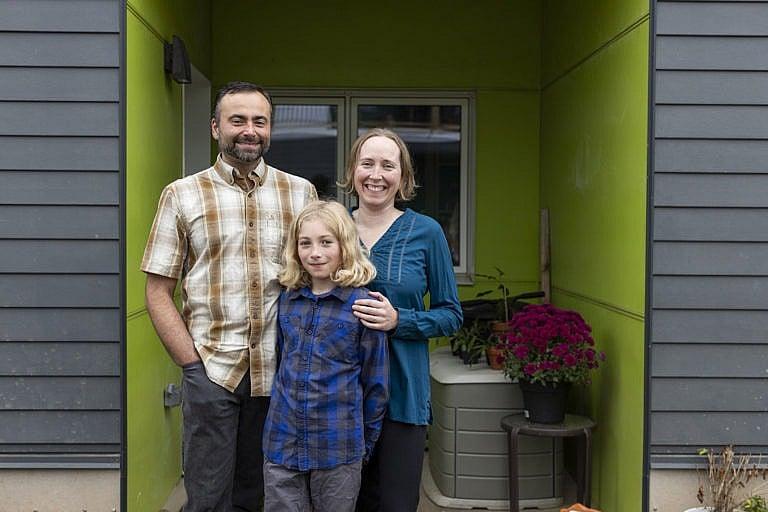This Nova Scotia co-housing community is creating connections—and more affordable homes
“I’m proud of what we’ve built—for a group of amateurs, it’s quite an accomplishment”

Share

For more than a decade, Cate de Vreede dreamed of living in a co-housing community—a village where residents have private homes but share common areas and amenities. De Vreede, an environmental and sustainability educator from Bridgewater, Nova Scotia, first developed a liking for these communities when she visited the West Coast of Canada 12 years ago: British Columbia has a dozen, including Belterra Cohousing on Bowen Island and Chemainus Cohousing near Victoria. De Vreede liked how co-housing communities fostered strong relationships between neighbours and encouraged children to form social bonds with people outside their immediate families. She was also drawn to the eco-friendly features of the villages she saw, like solar-powered homes and carpooling programs.

At the time, de Vreede and her husband, a city policy planner, had already bought a two-bedroom condo and started a life in Bridgewater. After Cate gave birth to their son Dylan in 2013, the de Vreedes thought about having another child. But a year later, Cate had a heart attack, making it difficult for her to conceive a second time. “It motivated us to build a family in another way,” she says. “We wanted a village in which to raise a child, with trustworthy neighbours and also the privacy of one’s own home. But we lived in a society where parenting in isolation has become the norm.”

De Vreede scoured the province, but she couldn’t find any co-housing villages in Nova Scotia. So she decided to create her own. The first challenge: raising capital and rallying investor interest. Her vision of a 30-house village was going to cost a whopping $13 million. She hosted information meetings and online seminars, and posted on social media in hopes of joining forces with like-minded people. She managed to persuade a handful of friends and acquaintances to get on board with the idea, but none of them were able to secure government funding or grants. “We didn’t know how to take our group meetings and potlucks and turn them into a multi-million-dollar investment,” she says.

De Vreede quit her job in 2018 to focus on her dream. She consulted with people who’d helped to create co-housing communities on the West Coast, and they gave her an idea. She created and incorporated a development company with 30 shares. Each household that was willing to live in the community would have to pay for their house up front; in exchange, they’d become shareholders in the neighbourhood. Then, once village construction was complete, the development company would become a condo corporation, and every shareholder would take ownership of their home.
READ: This Ontario hospital network is prescribing housing to patients—and building homes on its property
Using this new business model, de Vreede gathered investors from Nova Scotia, Vancouver and even people who moved from Germany and Kenya. She bought a 15-acre lot of mostly forested land in Bridgewater for $64,000, and started the build in 2021. Treehouse Village, a cluster of 30 one-, two- and three-bedroom houses is now set to become the first co-housing project in Atlantic Canada, and the largest of its kind in Canada when construction finishes by the end of this year.

In the new community, each family will own a private home. They’ll all share a 4,100-square-foot common activities house and meeting ground, 10 acres of surrounding land and a communal garden. They’ll also partake in community programs like meal rotations, childcare services and car sharing. Participation in these initiatives, which are still in the works, will be voluntary. People will also be expected, but not forced, to help out with duties like cleaning, snow shovelling and bookkeeping. Currently, 11 of the houses are already occupied. The goal is to have all 30 houses finished and inhabited by December.

The homes, all open-concept units with triple-pane windows and nine-foot ceilings, come in five styles. The smallest is a one-bedroom Fir house that measures 650 square feet and is reminiscent of a classic city condo, while the largest is a 1,300-square-feet, three-bedroom house that can accommodate a large or multi-generational family. People can choose their own flooring and countertops, and have the freedom to paint or decorate as they like; some residents are already building their own cupboards and heat pumps, says De Vreede.
READ: Why Canada might just need a tenant revolution
The residences, equipped with solar panels, require 75 per cent less energy to heat than a similar code-built home. De Vreede says yearly heating bills amount to barely $200. Meanwhile, robust construction materials like insulated concrete form and polystyrene-coated concrete walls extend the buildings’ predicted lifespan to more than 200 years. The community also has 28 electric vehicle chargers and real-time energy monitors in each unit.
All in, community buy-in ranges from between $400,000 and $685,000, depending on home size. According to de Vreede, the rising cost of building materials and a dearth of external investors left them no choice but to price the units higher than they’d anticipated. “The good thing is they cost very little to maintain.”
READ: This remote, fire-resistant Okanagan home was modelled after the mountain beetle
As buildings reach completion, residents are trickling into the community. There’s a photographer from Halifax, a pair of teachers with three young children, a linguist from the Netherlands and a retired teacher who helped build a school in Madagascar. Common activities like dinners and car sharing are expected to begin by early next year.

Now that she’s seeing it come to life, de Vreede hopes Treehouse Village inspires the creation of more co-housing arrangements in her province and on the East Coast of Canada. “We have realized the importance of social connectivity over the past few years, and how important a neighbourhood and community can be to mental well-being,” she says. “I’m proud of what we’ve built—for a group of amateurs, it’s quite an accomplishment.”